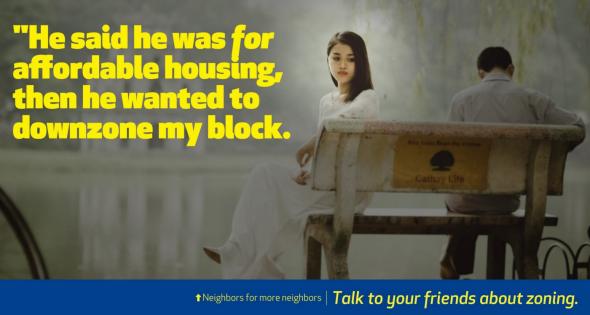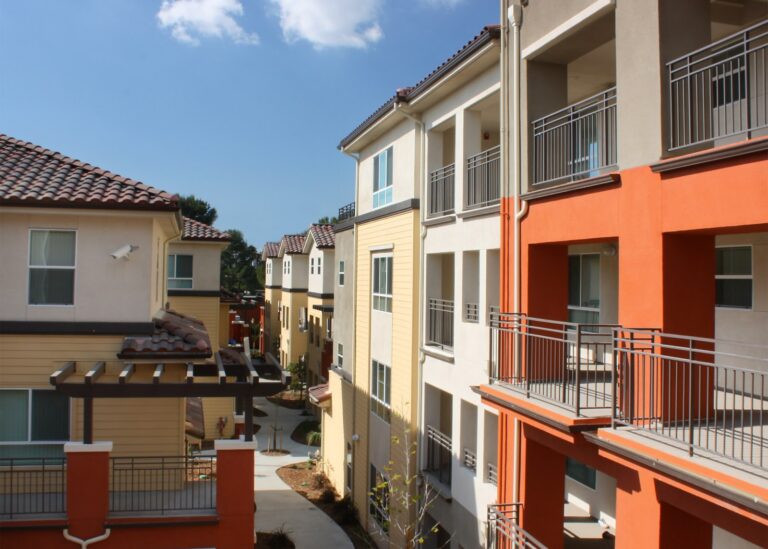Physical Address
304 North Cardinal St.
Dorchester Center, MA 02124
Physical Address
304 North Cardinal St.
Dorchester Center, MA 02124
Market Urbanism may soon have a hearing in the Supreme Court. Two of my colleagues at the Mercatus Center, Sandy Ikeda, half a dozen other professors, and I argue that the Court should take up the case 616 Croft Ave., LLC, v. City of West Hollywood. The case is an opportunity for the Court to determine whether inclusionary zoning violates its standards for legal exactions from developers. Inclusionary zoning requires developers to rent or sell some units in new projects at below-market prices. The Court has established that local governments can only require benefits from developers when these benefits offset a public nuisance from the project. Inclusionary zoning fails this test. The facts of the case could have played out in many American cities. Real estate developers Shelah and Jonathan Lehrer-Graiwer purchased two single family homes that they replaced with 11 condo units. West Hollywood’s inclusionary zoning rule required them to either make 20 percent of the units in their new project available at below-market prices or to contribute $540,000 to the city’s affordable housing fund. The Pacific Legal Foundation is representing the Lehrer-Graiwers suit. They have petitioned the Supreme Court to review earlier decisions from California courts that upheld West Hollywood’s policy. West Hollywood’s inclusionary zoning policy states that its purpose is to “off-set development impacts” that new housing construction causes. This justification is based on the false assumption that new housing development raises housing prices by replacing older, cheaper housing with newer, more expensive housing. This fallacy may seem reasonable at first glance. New construction is often more expensive than the older homes it replaces. But as these once-new houses age, they become affordable to lower-income residents. New construction is the only way to increase housing supply, and new units have the potential to become market-rate affordable housing over time. Housing economists call this process “filtering.” One estimate puts the […]
The most interesting comment to my last post focused on one narrow issue: to what extent are vacant housing units second homes (and thus presumably less likely to be rented out) as opposed to units for rent/sale or held for other unknown reasons? Why does this matter? Because one might argue that even if overall vacancy rates are low, a high “second home rate” might be evidence that the city’s housing prices are rising because of nonresident investors. Unless I am missing something, 2015 American Community Survey data does not contain data at this level of detail. However, 2000 and 2010 Census data contains data on types of vacancies. Below are percentages of vacant units held (in the Census Bureau’s words) “for seasonal, recreational or occupational use.” 2000 2010 Expensive markets Manhattan 32.7 33.9 (3.3 pct of all housing units) San Francisco 22.4 17.9 Boston 12.6 15.2 Los Angeles 7.8 7.9 San Diego 26.8 23.5 Not-so-expensive markets Dallas 4.6 3.7 Houston 6.5 4.5 Philadelphia 2.5 3.2 Chicago 5.0 7.0 On the one hand, expensive markets tend to have more second homes (evidence of a wave of outsider capital). But if such outsider capital was a major cause of rising housing prices, one would expect the “second home percentage” to grow over the 2000s. Instead, this number has been pretty stable. Moreover, this group of vacancies is a pretty small percentage of the overall housing market- a bit over percent in Manhattan, and a little over 1 percent in New York City as a whole (since second homes are not so common in the other boroughs).
One common argument against new urban housing runs as follows: “If we build new housing, it will all be bought up by rich investors who will sit on it. So new supply doesn’t restrain housing costs.” This argument (at least as I have phrased it) strikes me as absurd. Here’s why: for the argument to justify restraining supply, the argument presupposes that if you build 100 new condos/houses/apartments, every single one of them will be bought by an investor, and every single investor will irrationally choose to sit on the unit rather than renting it out. I can’t prove this is wrong, but it seems really hard to believe.* Even leaving aside the logical weirdness of the argument, it seems to have a questionable factual basis. If there was really a wave of nonresident investors in expensive cities, we might find (1) that the most expensive markets had the highest housing vacancy rates and (2) that these vacancy rates have been rising as housing costs rose. But Census data suggests otherwise. Here’s some data: (all for central cities, not metros) Expensive 2010 2015 Manhattan 12.7% 13% San Francisco 9.8 7.9 Los Angeles 6.7 6.5 San Diego 7.8 7.1 Boston 9.1 8.0 Not so Expensive 2010 2015 Dallas 12.8% 10.6% Houston 14.0 12.1 Philadelphia 14.1 13.3 Chicago 13.8 13.2 By and large, the expensive cities have lower vacancy rates- exactly what you would expect in a free market. The only exception is Manhattan. But it seems to me that if pied-a-terres led to higher rents, Manhattan’s empty-house rate would have climbed as rents did- which does not seem to have been the case. The only way to save the “empty house” theory is to suggest that expensive cities’ empty houses are different from everyone else’s – that is, they are especially […]

Last week, I posted about an attack on YIMBYs (activists who favor less zoning and more housing) that used the term “alt-right”; the authors of that blog post recently doubled down with a slightly more moderate op-ed that still tarred YIMBYs as “aligned with conservative right-wing libertarianism.” In fact, the Obama Administration is on the same side as YIMBYs; I recently published an article about their 2016 policy paper on urban housing. Read all about it here.
In 2005, Joseph Gyourko published an economic history of Philadelphia. He explored the economic and policy factors that contributed to its population and job loss during the twentieth century. Gyourko’s outlook for Philadelphia was pessimistic. He argued that the city lacked the supply of skilled labor that would allow it to adapt to the rise of the service sector. However, in the year following Gyourko’s publication, Philadelphia’s population growth rate reversed, driven by foreign immigration and college graduates choosing to stay in the city where they went to school. In spite of this growth, the city has maintained an impressive level of housing affordability. Philadelphia obviously hasn’t had the level of demand pressure other coastal cities like New York or San Francisco have seen, but since 2005, it has experienced steady population has growth from 1,400,000 to 1,550,000 people. Among potentially comparable mid Atlantic and midwest cities, only Pittsburgh has lower prices. During its decade of population growth, Philadelphia’s home prices essentially tracked the rate of inflation. Unlike newer cities that have the option of relatively cheap greenfield development, the Census designates nearly all of Philadelphia’s neighborhood as urban, the densest designation. The city’s population growth has been accommodated through infill development and the renovation of old homes rather than through greenfield development. It’s not the case that Philadelphia’s zoning regime accommodates as-of-right growth. Philadelphia developers have to deal with a complex web of outdated Euclidean zoning rules and myriad overlays. But developers have generally been able to get the variances they need to provide a supply of housing that keeps prices from rising in response to population growth. Philadelphia doesn’t have organized political opposition comparable to NIMBY activity in more expensive cities. Residents’ reaction to calls for community involvement in the development process demonstrates the city’s anti-NIMBY tendencies. In 2012 the city implemented zoning […]
This post was originally published at mises.org and reposted under a creative commons license. It’s no secret that in coastal cities — plus some interior cities like Denver — rents and home prices are up significantly since 2009. In many areas, prices are above what they were at the peak of the last housing bubble. Year-over-year rent growth hits more than 10 percent in some places, while wages, needless to say, are hardly growing so fast. Lower-income workers and younger workers are the ones hit the hardest. As a result of high housing costs, many so-called millennials are electing to simply live with their parents, and one Los Angeles study concluded that 42 percent of so-called millennials are living with their parents. Numbers were similar among metros in the northeast United States, as well. Why Housing Costs Are So High? It’s impossible to say that any one reason is responsible for most or all of the relentless rising in home prices and rents in many areas. Certainly, a major factor behind growth in home prices is asset price inflation fueled by inflationary monetary policy. As the money supply increases, certain assets will see increased demand among those who benefit from money-supply growth. These inflationary policies reward those who already own assets (i.e., current homeowners) at the expense of first-time homebuyers and renters who are locked out of homeownership by home price inflation. Not surprisingly, we’ve seen the homeownership rate fall to 50-year lows in recent years. But there is also a much more basic reason for rising housing prices: there’s not enough supply where it’s needed most. Much of the time, high housing costs come down to a very simple equation: rising demand coupled with stagnant supply leads to higher prices. In other words, if the population (and household formation) is […]

The far-left “TruthOut” web page recently published an attack on YIMBYs,* describing them as an “Alt-Right” group (despite the fact that the Obama Administration is pro-YIMBY). I was surprised how little substance there was to the article; most of it was various ad-hominem attacks on YIMBY activists for cavorting with rich people. I only found two statements that even faintly resembled rational arguments. First, the article suggests that only current residents’ interests are worth considering in zoning policy, because “the people who haven’t yet moved in” most often means the tech industrialists, lured by high salaries, stock options and in-office employee benefits like massage therapists and handcrafted kombucha.” This statement is no different than President Trump’s suggestion that Mexican immigrants “[are] bringing drugs. They’re bringing crime. They’re rapists.” – that is, it is an unverifiable (if not bigoted) generalization about large numbers of people. Furthermore, it doesn’t make sense. The “tech industrialists” have the money to outbid everyone else, so they aren’t harmed by restrictive zoning. Second, the article states that academic papers aren’t as relevant as the actual experiences of San Franciscans displaced by high housing costs. In response to the argument that less regulation means cheaper housing, it states “tell that to people like Iris Canada, the 100-year-old Black woman who had used local regulations to stay in her home of six decades, only to be evicted in February.” So in other words, somebody was evicted in San Francisco, therefore San Francisco’s restrictive zoning prevents eviction. I don’t see how the latter follows from the former. The whole point of the YIMBY/market urbanist argument is that if there was more housing, there would be lower housing costs, hence fewer evictions. *For those of you who are unfamiliar with the term, YIMBY means “Yes In My Back Yard”, a […]
Caos Planejado, in conjunction with Editora BEI/ArqFuturo, recently published A Guide to Urban Development (Guia de Gestão Urbana) by Anthony Ling. The book offers best practices for urban design and although it was written for a Brazilian audience, many of its recommendations have universal applicability. For the time being, the book is only available in Portuguese, but after giving it a read through, I decided it deserved an english language review all the same. The following are some of the key ideas and recommendations. I hope you enjoy. GGU sets the stage with a broad overview of the challenges facing Brazilian cities. Rapid urbanization has put pressure on housing prices in the highest productivity areas of the fastest growing cities and car centric transportation systems are unable to scale along with the pace of urban growth. After setting the stage, GGU splits into two sections. The first makes recommendations for the regulation of private spaces, the second for the development and administration of public areas. Reforming Regulation Section one will be familiar territory for any regular MU reader. GGU advocates for letting uses intermingle wherever individuals think is best. Criticism of minimum parking requirements gets its own chapter. And there’s a section a piece dedicated to streamlining permitting processes and abolishing height limits. One interesting idea is a proposal to let developers pay municipalities for the right to reduce FAR restrictions. This would allow a wider range of uses to be priced into property values and create the institutional incentives to gradually allow more intensive use of land over time. Meeting People Where They Are Particular to the Brazilian experience is a section dedicated to formalizing informal settlements, or favelas. These communities are found in every major urban center in the country and often face persistent, intergenerational poverty along with […]

Inclusionary zoning allows a few people to live in desirable, new construction buildings for much less than market rates. But it also carries with it a slew of perverse consequences. Because it’s a tax on construction, it reduces supply. Inclusionary zoning also leads developers to build higher-end buildings than they would otherwise, further squeezing out lower- and middle-income tenants. While inclusionary zoning makes life easier for a few middle- and high-income residents lucky enough to secure below market-rate units in expensive cities, it also contributes to the regulatory mess that constrains housing supply in general. This in turn drives up the cost of housing. The effects of these supply constraints fall hardest on low-income residents who can least afford artificially high housing costs. By placing further constraints on housing markets, inclusionary zoning makes it so that resources dedicated to providing housing for the truly needy don’t go as far as they could in a less regulated market. Subsidies to middle-income residents come with the unfortunate side effect of making it more difficult for non-profits and government programs to make housing accessible to the truly needy. Recently I presented on a panel at Chapman University on the future of housing in Orange County. Our panel highlighted the tensions between housing programs designed to help low-income and homeless households and those designed to help middle-income households. While my talk focused on regulatory barriers that make housing unaffordable for people across the income spectrum, Maria Cabildo — a former non-profit developer for low-income housing — talked about her experiences building housing for the homeless and very-low-income families. Maria pointed out that market-rate housing is too expensive for minimum wage earners in every single county in the country. In expensive markets, policies designed to subsidize housing for middle-income people drives prices even farther out of reach for low-income […]
Thanks to Stephen Smith, I recently ran across an interesting database: HUD data on building permits by municipality. So I decided to find the number of permits per 1,000 for a wide variety of cities, focusing on (1) multifamily permits (because rising rent is a bigger problem in most places than rising home costs) and (2) during 2015 and 2016 (because isn’t two years of data always better than one?). Here’s what I found for the places I bothered to look up: Growing high cost cities permits per 1000/mean price for units with 5 or more structures in thousands Seattle 29.4 Denver 19.5 Washington 13.7 Boston 12.5 Portland 12.2 Brooklyn 11.5 Manhattan 10.1 San Francisco 8.8 San Diego 7.6 Los Angeles 6.7 Growing low cost cities Atlanta 28.7 Dallas 15.3 Nashville 14.6 Austin 13.2 (not sure whether this counts as a low-cost city- really its kind of borderline) Charlotte 12 Columbus 7.4 Houston 6.8 Indianapolis 2.3 Low demand (i.e. declining) cities Chicago 5.4 St. Louis 3.6 Cincinnati 2.3 Milwaukee 2.2 Baltimore 2.1 Detroit 1.4 Another fun fact: suburbs of expensive cities lagged behind even the low-demand cities. Nassau and Suffolk Counties had 0.3 and 0.2 multifamily permits per 1000 respectively, Marin County outside San Francisco 0.7, Orange County outside Los Angeles 4.7. Some takeaways: 1. Low-demand cities generally had less building than even the most restrictive cities. 2. Within the high-cost city group, it seems to me that there is a strong correlation between permits and prices: Seattle and Denver are certainly cheaper than San Francisco or Los Angeles. 3. On the other hand, there were some low-cost cities that didn’t have a lot of new construction, like Houston and Indianapolis. But this weirdness can be explained away by looking at new single-family construction: Houston had more than […]